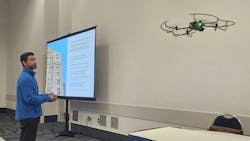How Drones and AI Make Facade Inspections Easier (Southern California Facilities Expo 2025)
The taller a building is, the more complicated and expensive it becomes to inspect its facade. Two emerging technologies—drones and artificial intelligence—are working together to simplify inspections, reduce costs, and make it easier to address facade problems before they become bigger issues, explained Sergey Kucher, founder and CEO of RayAccess, Inc., and Ethan Pisz, chief drone operator, in their Thursday morning session at the 2025 Southern California Facilities Expo.
How Do Drones Work?
Drones are unmanned aerial vehicles. For inspections, they’re equipped with high-quality cameras and sensors. The drones can be flown manually or follow an automated flight path; either strategy allows them to collect data quickly and efficiently.
“They can provide unique perspectives and capabilities that traditional inspections can’t match,” Pisz said. “Drones with high resolution cameras and sensors can be used to collect comprehensive visual data about a building and its surroundings. This data can be used to analyze any problems in the building’s facade.”
Why Use Drones to Inspect Buildings?
Because traditional methods of inspecting a facade are so time-consuming and expensive, the facade can sometimes be out of sight, out of mind—until there’s a leak. This reactive approach can encourage further damage, mold issues, and even affect your HVAC systems, Kucher said.
Air leaks, which can be identified with drones, force the HVAC system to work harder to maintain comfort inside. “That will lead to high energy bills to compensate for this loss,” Kucher added. “It will also lead to humidity issues because when there’s a difference in temperatures, you get condensation, and then you get mold in the building.”
Overusing the HVAC system will reduce the equipment’s lifespan because it’s now working to condition air outside the building, which it wasn’t designed to do, Kucher said.
Drones can help remedy problems by finding cracks, sealant and gasket failures, gutter damage, corrosion, and more.
“Leaks cause a lot of structural damage to your building. It’s causing corrosion, mold issues, and wood rot,” Kucher said. “Drone inspections help us to detect problems early and prevent potential issues.”
How Drones and AI Work Together
The photos and measurements captured by drones can be analyzed using AI, Pisz said. “Artificial intelligence can be trained to detect defects like small cracks, peeling sealant, or deformations,” he said. “The analysis can be added to our visual inspections.”
A 10-story building might result in tens of thousands of images that are then stitched together to create a 3D model of your building with all of the detected defects flagged. Human technicians can then manually inspect the AI’s findings and determine whether it correctly identified the defect, Pisz added. The final results can be added to a PDF report that gives a comprehensive overview of the building’s defects, which can be shared with stakeholders.
“Sometimes a visual inspection may overlook certain defects, whereas when you’re taking images of every square inch of the building and you have several sets of eyes on it, we can be a lot more efficient,” Pisz explained.
“Drones help us to collect data very quickly from buildings, and AI helps us plan the missions and analyze the pictures,” added Kucher. “No human would be able to analyze all of the images and look for all the cracks. AI helps us focus on what we can actually do.”
About the Author
Janelle Penny
Editor-in-Chief at BUILDINGS
Janelle Penny has been with BUILDINGS since 2010. She is a two-time FOLIO: Eddie award winner who aims to deliver practical, actionable content for building owners and facilities professionals.

